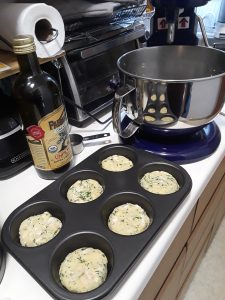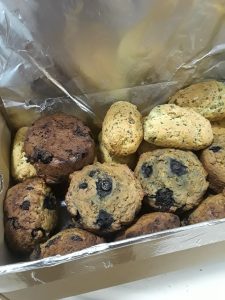Ladies and gentlebeings, here’s what I’ve come to after a 6 month period of, firstly, a strict diet of tapioca, carrots, butternut, apples, and chicken; then, careful reading about *tested* foods on *living* humans, plus extensive empirical testing on my own particular system. The fruits (, veg, herbs, and meats) of this work lies below. Foods that I currently remember as improving the histamine picture have a +.
Note: I’m focusing on what I *can* eat as part of a low-histamine diet. Where my diet is restricted for other reasons, I say so, in order to point out where there’s obviously something for others to explore.
I don’t mention higher-histamine foods nor do I go into the details of what makes a food low-histamine (which can involve mast cell triggering, histamine levels within the food, salicylates, non-food triggers that raise the background level of reactivity, whether fermentation or aging is inevitably part of the process – as with beef – and so on) because that’s a whole ‘n’other article, and a bit beyond my bludgeoned brain at the mo’.
Caveat emptor: we’re all a bit different. This is why empirical testing, tracking results for yourself, and being able to notice when things change, is so important. My list is basically ok in principle, but it won’t be right for everybody, and may not even be right for me in a couple of years.
Besides “everything organic” and “everything fresh”, the third leg of this mow-histamine diet is “everything freezable frozen”, because leftovers and meats start making histamines real quick. So, freezing and then defrosring in the microwave is the only safe way to go with yhese things.
I let stuff that’s fresh off the stove or out of the oven freeze up on the top shelf (usually atop the “buns” box) and then move it to its rightful place:

The magic lists
Everything, absolutely everything, is super fresh and organic. This is part of the deal with low-histamine foods, and I’m ever so grateful that it’s possible right now. (Thank you to the federal SNAP/Food Stamps system and to HIP, the produce-enhancing state funding system for low-income people, plus an outstanding local farmer’s market that works with these programs!)
Produce:
-
- +Apples, fresh local low-spray or organic (by low-spray, I mean they get sprayed twice, once when the buds set and once when the fruit sets. I find I tolerate this just fine, as long as the apples aren’t sprayed for storage)
- Fresh cider, UV treated to impede fermentation (when I’m not frail)
- Blueberries, wild
- Cranberries
- Peaches, when not frail
- Plums, most kinds, when not frail
- Cherries, when not frail
- Mangos (not bruised)
- Spring onions (some people are good with sweet white onions but not spring onions, and some can’t tolerate any onions, so YMMV)
- Garlic heads (as above)
- Sweet peppers (I find red bells and bullhorn peppers easiest to digest)
- +Asparagus
- Cauliflower, if good (no black or yellowed spots)
- Soft/summer squash: marrows, zucchini, yellow crookneck (scoop out seeds if currently fragile)
- Different squash: delicata, pattypan (seeded as above)
- Beet greens
- Radishes (which I like to steam)
- Celery

I can’t eat leafy cabbages because my fragile thyroid poops out if I do: mustard greens, collards, chard, bok choy, napa, savoy, radicchio, kale, green and purple cabbages, and other winter-harvest yumminess! Check them out for yourself, as long as your thyroid and gut is up to the job.Protein:
- Chicken, turkey, pork, lamb (frozen straight off the block; another farmer’s market item here) (NOT ground: that generates histamine, possibly from the extensive cell damage)
- Eggs (from scratching, soy-free hens)
I can’t eat lentils, beans, or peas due to gastroparesis, but you lucky so-and-sos who can might want to read up & experiment to see which ones are ok for you.
Lipids:
These have to be fresh and not have any whiff of rancidity. Since all my food is fresh now, these and my protein sources are my only source of lipids for my brain and spine:
- Olive oil
- Grassfed (or Kerrygold) fresh butter, not raw
- Avocado oil
- Drippings from cooking meats, frozen right out of the pan. These are *wonderful* for cooking veggies with!
- Coconut oil (when not frail)
Carbohydrate rich:
- Rice (plain whites, basmati, or jasmine are all ok for me; brown and sweet rice are not for frail times, but ok in small doses at other times)
- Sweet potatoes, any kind but Japanese (which I think I did to myself by eating them too often at one time! Darn it)
- Tapioca/yucca/manioc, same vegetable; fantastic for a sluggish gut & delicious made with apple cider
- Farmer’s market honey
- Sugars: panela, jaggury, coconut (all of them unrefined & mineral-rich, so YMMV)
- Beets – with greens (I use the stems to flavor soups and I steam the greens or drop them on top of a batch of stir fry; delicious!)
- Carrots, lots, as they go with everything
- Broccoli
- Parsnips, if I’m not currently frail (they’ve got such good nutrition I keep them on my shopping list, but they’re the first to go if I’m not up to the mast impact)
- Celeriac
- Hard/winter squash: butternut, acorn, kabocha (NOT pumpkin or spaghetti squash)
Rice is my only grain. Some do ok with sorghum or buckwheat or some other things, but it’s hard on me in anything but small doses & when I’m not reactive.
Flavorings and spices
I can do, almost all fresh:
- Parsley
- Basil
- Dandelion greens
- Cilantro
- Sumac (this is dried)
- Bay leaf (dried)
- Rosemary
- Sea salt
- Mined salts: Kosher, pink salts
- Garlic
- Ginger
- Turmeric
- Cedar sprig (fantastic when cooking chicken or buttered black beans, not that I can eat the beans any more)
- Cumin (when not fragile)
Here’s the fun part…
Recipes
The web is international, and I try to work with that 🙂 Please be aware that, as my cooking was learned in US-origin households and restaurants, I cook by volume rather than weight. Measurements are noted accordingly. (I’m aware of the flaws in this system, so I use recipes that can accommodate the “fudge factor.”)
These are much-loved ingredients I make ahead:
“Ginger Fabulous”
I almost took a picture of this, but it just looked brown on camera. It’s lovely earthy honey-colors IRL.
- Peels from 4-6 apples (may freeze ahead)
- Ginger x6-8 thumbs (a bit bigger than my smallish thumb, anyway)
- Farmer’s market local honey, ~1/2 cup [120 ml]
- Sugar (panela or jaggury for me; light brown or raw is probably good), same volume as honey
- 1 pint [500 ml] cider
- Optional: Dash of clove, if you’re ok with it
Slice ginger to 1/8″ or less.
Chop apple peels to about 3/4″ segments.
Put everything in a good pot.
Simmer until all the ginger is translucent, usually ~ 1/2 hour.
Let cool.
Try to keep enough for later; I find it hard to stop taste-testing.
Uses:
Use as is for preserves, or process/blenderise to rough texture for marinade, jam, or even hot drink if you don’t mind a bit of dessert in the bottom.“Super Greens”
Here they are mixed into buns:

- Parsley x6-8 bunches
- Basil x3 bunches
- Dandelion, Italian/less bitter (has spikier leaves), x1
Chop parsley and the leafier part of dandelion greens to 1/2″ lengths.
Pick basil leaves off stems and chop a bit smaller than that.
(Wrap the stems in foil and keep in freezer for flavoring soups, as their flavors cook down delightfully.)
Throw it all in a processor and chop very fine. (I have to go 1 head of parsley & equivalent of others at a time, because my processor is not that big.)
Package up into ice trays, or in foil or paper by ~dessert spoon or ~50 ml sizes and freeze.
Uses:
1 of these dresses 2 to 4 scrambled eggs or omelettes, depending on taste.
I take a batch and mix it with softened Kerrygold/grassfed (not cultured!) butter, to a ratio of 1 butter : 1 pressed-down greens by volume, and beat well into a super healthy spread. I refrigerate enough for a few days and freeze the rest. Way more yummy than something this healthy should be!“Isy’s elf-rising flour”
This recipe is taken from
alittleinsanity.com, but I removed the xanthan gum, use non-fungal risers, and make with organic flour ingredients. Its ingredients are friendly to systems dealing with inflammation and histamine problems. It makes buns, quickbreads, and muffins very quick & easy to put together. (I haven’t tried it with pancakes because I can’t limit my intake of pancakes sufficiently & don’t like to feel that sick, so doing without is my best bet rn.)This recipe uses weights because, for the most part, the ingredients are often packaged in these sizes so you just dump out a bag of each. Easy!
- 24 oz [0.7 kg] brown rice flour, fine
- 24 oz [0.7 kg] white rice flour, fine
- 24 oz [0.7 kg] sweet white rice flour
- 20 oz [0.6 kg] tapioca flour/starch (same thing)
- 2+1/2 [37.5 ml] Tablespoons baking soda
- 1 Tablespoon [15 ml] baking powder (I push this through a tea strainer to get all the clumps worked out. I abhor the taste of baking powder clumps)
- 2 Tablespoons [30 ml] salt
Blend carefully in a huge pot. I use both a paddle and a whisk, gently.
Take the time to get everything *very thoroughly blended*.
This makes a gallon plus 1.5 cups, or about 4 liters.Uses:
This makes a forgiving dough, and will generally work out fine.2.5 cups [or about 750 ml] of flour will take:
- 5 to 7 tablespoons[75-100 ml] of butter (maybe more; tell us if you try it?)
- 1/3 cup [80 ml] liquid
- 1/4 cup [60 ml] to 1/2 cup [120 ml] of sugar
- Eggs, 1 to 4…
If you use 1 egg per 2.5 cups of flour mix, it gives a texture suitable for scones or gf (American) biscuits.
If you use 3-4 eggs per 2.5 cups of flour mix, it results in a soft, puffier texture with more volume, as for quickbreads [teacakes] or (American) muffins.
Additions
It adapts well: you can use water, broth, milk, or cider as the liquid, and can add as little as 1/2 cup [120 ml] or as much as 1+1/4 cups [300 ml] of diced chicken or Super Greens or wild blueberries – with or without some Ginger Fabulous – and still get a wonderful result.It bakes in 12-15 muffin tins (depending on the extras) at 350*F [175*C] for 16 to 20 minutes in my oven, or until there’s no steam in the scent from the oven / toothpick comes out dry.
Here are chicken buns & blueberry teacakes in their freezer box. Defrost & warm by microwave on low for 30 seconds on top and 30 seconds on bottom.

I’m still working out a recipe for lembas, but it’s only a matter of time. Buns made from this are light & crumbly all right, and certainly very filling!